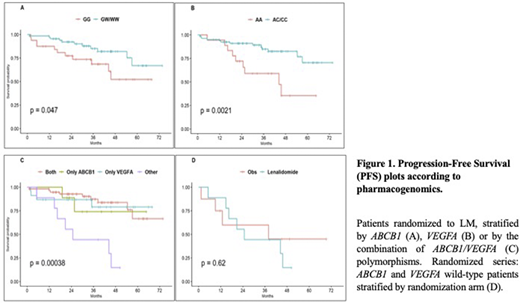
Background and Aims. Prediction of treatment efficacy is an active and growing field of pharmacology. In the Fondazione Italiana Linfomi (FIL) MCL0208 phase III trial (NCT02354313), a 24 months lenalidomide maintenance (LM, 15 mg days 1-21 every 28 days) after high-dose immuno-chemotherapy followed by autologous transplantation (ASCT) in 300 frontline mantle cell lymphoma (MCL) patients showed substantial clinical activity in terms of Progression-Free Survival (PFS) vs observation (OBS). However, this benefit seemed not uniform across patient series. To deeper investigate the differential pattern of response to lenalidomide, a wide analysis of the host pharmacogenomics (PG) background was planned, in order to dissect whether specific germline polymorphisms of transmembrane transporters, metabolic enzymes or cell surface receptors (ABCB1, ABCG2, VEGFA, FCGR2A, NCF4, GSTP1, CRBN) might predict the drug efficacy. Actually, several single nucleotide polymorphisms (SNPs) of ABCB1 exert an effect on substrate affinity of lenalidomide for the transmembrane transporter. Moreover, VEGFA is involved in the anti-angiogenic activity of lenalidomide and might eventually upregulate ABCB1 expression, too. Patients and methods. Genotypes for SNPs were obtained through allele-specific (ASO) probes on germline DNA from peripheral blood. Minor allele frequencies (MAFs) were obtained and the Hardy-Weinberg equilibrium (HWE) was checked. Genotypes were used to infer individual haplotypes by Arlequin and Haploview softwares. Minimal residual disease (MRD) was assessed with ASO primers on either IGH or BCL-1/IGH rearrangements by RQ-PCR in bone marrow samples. TP53 disruption was identified by NGS targeting resequencing and copy number variation analysis. Clinical-biological correlations were screened by automated machine learning methods and validated by both Kaplan-Meier at univariate level and Cox models for multivariate analysis (MV). A logistic regression was implemented to investigate correlations between polymorphisms and MRD kinetics. Results. 278 out of 300 patients (93%) were fully genotyped. The MAF values of the SNPs were very similar to published data and the HWE was confirmed. Most notably, ABCB1 c.2677G>T/A(W) and VEGFA c.2055A>C were significantly associated to outcome and are thus described in this abstract. In the case of ABCB1, the three loci were in strong linkage disequilibrium (p<0.001). 31% of patients were homozygous for ABCB1 wild type alleles (GG, "WT"), 53% heterozygous (GW, "HET") and 16% polymorphic on both chromosomes (WW, "POL"). 20% were VEGFA WT (AA), 47% HET (AC) and 33% POL (CC). PG did not impact on induction therapy and randomization rates of this trial, as superimposable polymorphism frequencies were described between the enrolled and randomized population. Conversely, both ABCB1 HET and POL and VEGFA HET/POL associated with higher MRD clearance rates vs WT after 6 months of LM (93% vs 71% and 91% vs 67%, respectively). Interestingly, the risk of MRD reappearance during LM was 86% lower for patients harboring either polymorphism vs WT (odds ratio 0.14, 95% CI 0.02-0.99; p<0.05). Actually, ABCB1 HET/POL predicted for a more favorable PFS vs WT in LM (3yPFS 85% vs 69% p<0.05, Fig.1A), as well as VEGFA HET/POL (3yPFS 85% vs 59% p<0.01, Fig.1B). The two polymorphisms co-occurred in 57% of patients, being 12% ABCB1 HET/POL only, 23% VEGFA HET/POL and 8% ABCB1/VEGFA WT. Interestingly, patients with either polymorphism had superimposable outcome to patients in whom both co-occurred (Fig.1C). Finally, MV showed that either polymorphism was protective for PFS among randomized patients (HR=0.42; 95% CI 0.20-0.85; p<0.05). According to this hypothesis, among the 17 ABCB1/VEGFA WT patients LM did not improved PFS vs OBS (Fig.1D), independently from TP53 disruption. Conclusions. The first PG data on LM after ASCT in MCL suggested that: 1) ABCB1 and VEGFA polymorphisms did not impact on the chemotherapeutic efficacy of FIL-MCL0208 trial; 2) both polymorphisms favored sustained MRD clearance during LM; 3) either polymorphism conferred a survival advantage during LM. Taken together, these observations hint that a variable excretion of lenalidomide through ABCB1 (heralded by SNPs), as well as an altered VEGFA pathway, could predict treatment efficacy. This observation might be very useful in the future to tailor lenalidomide therapy to MCL patients.
Ferrero:Servier: Speakers Bureau; Gilead: Research Funding, Speakers Bureau; EUSA Pharma: Honoraria, Membership on an entity's Board of Directors or advisory committees, Speakers Bureau; Janssen: Consultancy, Honoraria, Membership on an entity's Board of Directors or advisory committees, Speakers Bureau. Boccomini:SC Ematologia, ASOU Città della Salute e della Scienza di Torino, Turin, Italy: Current Employment. Maria:Roche: Consultancy, Other: travel, accomodations, expenses; Abbvie: Consultancy, Other: travel, accomodations, expenses; BMS: Consultancy; MSD: Consultancy; Janssen: Consultancy, Other: travel, accomodations, expenses; Gilead: Consultancy, Other: travel, accomodations, expenses, Research Funding. Ferreri:Gilead: Membership on an entity's Board of Directors or advisory committees, Research Funding; Morphosys: Research Funding; Hutchinson: Research Funding; BMS: Research Funding. Palumbo:Novartis: Honoraria, Membership on an entity's Board of Directors or advisory committees, Speakers Bureau; Celgene: Honoraria, Membership on an entity's Board of Directors or advisory committees, Speakers Bureau; Amgen: Honoraria, Membership on an entity's Board of Directors or advisory committees, Speakers Bureau. Galimberti:Novartis: Speakers Bureau; Incyte: Honoraria.
Lenalidomide maintenance in mantle cell lymphoma
Author notes
Asterisk with author names denotes non-ASH members.

This icon denotes a clinically relevant abstract


This feature is available to Subscribers Only
Sign In or Create an Account Close Modal